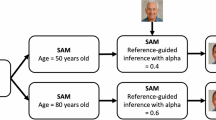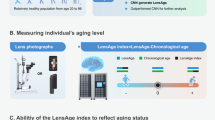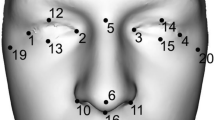Abstract
Aging is associated with many complex diseases. Reliable prediction of the aging process is important for assessing the risks of aging-associated diseases. However, despite intense research, so far there is no reliable aging marker. Here we addressed this problem by examining whether human 3D facial imaging features could be used as reliable aging markers. We collected > 300 3D human facial images and blood profiles well-distributed across ages of 17 to 77 years. By analyzing the morphological profiles, we generated the first comprehensive map of the aging human facial phenome. We identified quantitative facial features, such as eye slopes, highly associated with age. We constructed a robust age predictor and found that on average people of the same chronological age differ by ± 6 years in facial age, with the deviations increasing after age 40. Using this predictor, we identified slow and fast agers that are significantly supported by levels of health indicators. Despite a close relationship between facial morphological features and health indicators in the blood, facial features are more reliable aging biomarkers than blood profiles and can better reflect the general health status than chronological age.
Similar content being viewed by others
Log in or create a free account to read this content
Gain free access to this article, as well as selected content from this journal and more on nature.com
or
References
Lopez-Otin C, Blasco MA, Partridge L, Serrano M, Kroemer G . The hallmarks of aging. Cell 2013; 153:1194–1217.
Han JD . An aging program at the systems level? Birth Defects Res C Embryo Today 2012; 96:206–211.
Rando TA, Chang HY . Aging, rejuvenation, and epigenetic reprogramming: resetting the aging clock. Cell 2012; 148:46–57.
Pallis AG, Hatse S, Brouwers B, et al. Evaluating the physiological reserves of older patients with cancer: the value of potential biomarkers of aging? J Geriatr Oncol 2014; 5:204–218.
Sun B, Edgar MP, Bowman R, et al. 3D computational imaging with single-pixel detectors. Science 2013; 340:844–847.
Wirthlin J, Kau CH, English JD, Pan F, Zhou H . Comparison of facial morphologies between adult Chinese and Houstonian Caucasian populations using three-dimensional imaging. Int J Oral Maxillofac Surg 2013; 42:1100–1107.
Kasperaviciute D, Catarino CB, Chinthapalli K, et al. Uncovering genomic causes of co-morbidity in epilepsy: gene-driven phenotypic characterization of rare microdeletions. PLoS One 2011; 6:e23182.
Cox-Brinkman J, Vedder A, Hollak C, et al. Three-dimensional face shape in Fabry disease. Eur J Hum Genet 2007; 15:535–542.
Hammond P, Suttie M . Large-scale objective phenotyping of 3D facial morphology. Hum Mutat 2012; 33:817–825.
Coleman SR, Grover R . The anatomy of the aging face: volume loss and changes in 3-dimensional topography. Aesthet Surg J 2006; 26:S4–S9.
Zimbler MS, Kokoska MS, Thomas JR . Anatomy and pathophysiology of facial aging. Facial Plast Surg Clin North Am 2001; 9:179–187, vii.
Asakura K, Nishiwaki Y, Milojevic A, et al. Lifestyle factors and visible skin aging in a population of Japanese elders. J Epidemiol 2009; 19:251–259.
Shaw RB Jr, Katzel EB, Koltz PF, et al. Aging of the facial skeleton: aesthetic implications and rejuvenation strategies. Plast Reconstr Surg 2011; 127:374–383.
Jenkins R, Burton AM . 100% accuracy in automatic face recognition. Science 2008; 319:435.
Geng X, Zhou ZH, Smith-Miles K . Automatic age estimation based on facial aging patterns. IEEE Trans Pattern Anal Mach Intell 2007; 29:2234–2240.
Guo G, Mu G . Joint estimation of age, gender and ethnicity: CCA vs PLS. IEEE International Conference and Workshops on Automatic Face and Gesture Recognition (FG) 2013:1–6.
Guo G, Fu Y, Dyer CR, Huang TS . Image-based human age estimation by manifold learning and locally adjusted robust regression. IEEE Trans Image Process 2008; 17:1178–1188.
Hutton TJ, Buxton BF, Hammond P, Potts HW . Estimating average growth trajectories in shape-space using kernel smoothing. IEEE Trans Med Imaging 2003; 22:747–753.
Turaga P, Biswas S, Chellappa R . The role of geometry in age estimation. IEEE International Conference on Acoustics Speech and Signal Processing (ICASSP) 2010:946–949.
Guo J, Mei X, Tang K . Automatic landmark annotation and dense correspondence registration for 3D human facial images. BMC Bioinformatics 2013; 14:232.
Peng S, Tan J, Hu S, et al. Detecting genetic association of common human facial morphological variation using high density 3D image registration. PLoS Comput Biol 2013; 9:e1003375.
Abdi H, Williams LJ . Partial least squares methods: partial least squares correlation and partial least square regression. Methods Mol Biol 2013; 930:549–579.
Zhang W, Liu Y, Sun N, et al. Integrating genomic, epigenomic, and transcriptomic features reveals modular signatures underlying poor prognosis in ovarian cancer. Cell Rep 2013; 4:542–553.
LI Y, ZHENG L, YU K, et al. Variation of head and facial morphological characteristics with increased age of Han in Southern China. Chinese Science Bulletin 2013; 58:517–524.
Peng L, Minbo H, Fang C, Xi L, Chaocan Z . The interaction between cholesterol and human serum albumin. Protein Pept Lett 2008; 15:360–364.
Sankaranarayanan S, de la Llera-Moya M, Drazul-Schrader D, Phillips MC, Kellner-Weibel G, Rothblat GH . Serum albumin acts as a shuttle to enhance cholesterol efflux from cells. J Lipid Res 2013; 54:671–676.
Zhao Y, Marcel YL . Serum albumin is a significant intermediate in cholesterol transfer between cells and lipoproteins. Biochemistry 1996; 35:7174–7180.
Scherbaum K, Sunkel M, Seidel HP, Blanz V . Prediction of individual non-linear aging trajectories of faces. Eurographics 2007; 26:285–294.
Weidner CI, Lin Q, Koch CM, et al. Aging of blood can be tracked by DNA methylation changes at just three CpG sites. Genome Biol 2014; 15:R24.
Aynechi N, Larson BE, Leon-Salazar V, Beiraghi S . Accuracy and precision of a 3D anthropometric facial analysis with and without landmark labeling before image acquisition. Angle Orthod 2011; 81:245–252.
Wold S, Sjöström M, Eriksson L . PLS-regression: a basic tool of chemometrics. Chemometr Intell Lab Syst 2001; 58:109–130.
Mevik B-H, Wehrens R . The pls Package: principal component and partial least squares regression in R. J Statis Softw 2007; 18:1–24.
Chang CC, Lin CJ . LIBSVM: A library for support vector machines. ACM Trans Intell Syst Technol 2011; 2:1–27.
Acknowledgements
We are grateful to the individuals who volunteered for the study. We thank Chi Xu, Wenxuan Gong, Hao Cheng, Dan Wang, Jing Li, Bing Zhou, Wei Zhang, Na Sun, Veronica Chen, Yue Qu, Xia Tang, Jian Lu and Xiaoli Miao for the help in data collection. We thank Jing Guo and Hang Zhou for the help in the use of the 3dMDface system. This work was supported by the China Ministry of Science and Technology (2011CB504206 and 2015CB964803 to JDJH, and 2012AA020406 to GW), the National Natural Science Foundation of China (91019019, 31210103916 and 91329302 to JDJH, 31371188 to GW, and 31350110327 to CDG) and the Chinese Academy of Sciences (CAS; YZ201243 and XDA01010303 to JDJH). GW acknowledges supports from Shanghai Institutes for Biological Sciences (SIBS), CAS (2011KIP202) and the SA-SIBS Scholarship Program. CDG holds a CAS fellowship (2010Y2SB06), and Shanghai Institute for Biological Sciences Postdoctoral Fellowship (2013KIP315).
Author information
Authors and Affiliations
Corresponding author
Additional information
( Supplementary information is linked to the online version of the paper on the Cell Research website.)
Supplementary information
Supplementary information, Figure S1
Correlation of age predicted by facial vertices-based PLSR predictors with the actual age of the subjects. (PDF 907 kb)
Supplementary information, Figure S2
Age predicted by 3D facial image vertices-based SVR predictors. (PDF 1322 kb)
Supplementary information, Figure S3
Differences between predicted and actual ages in each age group and the mean 3D facial images in well predicted, slow- and fast-ager classes of younger age groups. (PDF 190 kb)
Supplementary information, Figure S4
Levels of other age-correlated blood health indicators in predicted fast-agers, slow-agers and well predicted subjects when the classification is based on the age difference > 6 years between predicted age and chronological age. (PDF 373 kb)
Supplementary information, Figure S5
The distribution of RCCs between each Cluster 1/6 blood health indicator and the predicted slow- and fast-ager classifications or that between each health indicator and permuted classifications within each age group. (PDF 720 kb)
Supplementary information, Figure S6
Levels of the blood health indicators (showed in Fig. 3E) in predicted fast-agers, slow-agers and well-predicted subjects when the classification is based on the age difference > 7 years between predicted age and chronological age. (PDF 183 kb)
Supplementary information, Figure S7
Correlation between blood indicators and predicted/chronological age in slow- and fast-agers (|predicted age — chronological age| > 6). (PDF 184 kb)
Supplementary information, Figure S8
The loading values of PLS component 1 of the new PLS model adjusted for BMI (A) or for cholesterol, LDLC and albumin (B) in three dimensions. (PDF 161 kb)
Supplementary information, Figure S9
The heat map of 3D-effects showing loading values of PLS component 1 correlated with other indicators from 18 blood serum indicators and 24 blood-cell related indicators (except CHO, LDL-C, HDL-C and ALB in Fig. 4) on female and male faces. (PDF 1487 kb)
Supplementary information, Table S1
Age distribution of subjects. (PDF 15 kb)
Supplementary information, Table S2
Pearson Correlation Coefficients (PCCs) of each feature or component with chronological age. (PDF 21 kb)
Supplementary information, Table S3
The distribution of cumulative explained variance. (PDF 12 kb)
Supplementary information, Table S4
Correlations between ages predicted by the PLS model with or without adjusting for the age associated features, BMI, or LDLC, cholesterol and albumin. (PDF 10 kb)
Supplementary information, Table S5
Correlations between age predicted by the PLS model with or without removing image features/vertices that are highly correlated (PCC>=0.3) to the age associated features, BMI, or LDLC, cholesterol and albumin. (PDF 8 kb)
Supplementary information, Data S1
Supplementary Notes (PDF 289 kb)
Rights and permissions
About this article
Cite this article
Chen, W., Qian, W., Wu, G. et al. Three-dimensional human facial morphologies as robust aging markers. Cell Res 25, 574–587 (2015). https://doi.org/10.1038/cr.2015.36
Received:
Revised:
Accepted:
Published:
Issue date:
DOI: https://doi.org/10.1038/cr.2015.36
Keywords
This article is cited by
-
Coordinate-wise monotonic transformations enable privacy-preserving age estimation with 3D face point cloud
Science China Life Sciences (2024)
-
Association between adiposity and facial aging: results from a Mendelian randomization study
European Journal of Medical Research (2023)
-
Central obesity and its association with retinal age gap: insights from the UK Biobank study
International Journal of Obesity (2023)
-
Three-dimensional analysis of modeled facial aging and sexual dimorphism from juvenile to elderly age
Scientific Reports (2022)
-
Why Gilgamesh failed: the mechanistic basis of the limits to human lifespan
Nature Aging (2022)



